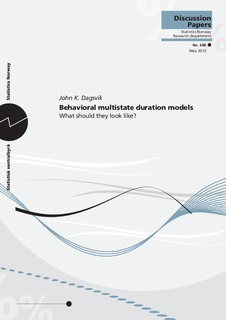Behavioral multistate duration models : what should they look like?
Working paper

Åpne
Permanent lenke
http://hdl.handle.net/11250/179915Utgivelsesdato
2012Metadata
Vis full innførselSamlinger
- Discussion Papers [1003]
Sammendrag
Abstract:
This paper discusses how specification of probabilistic models for multistate duration data generated by individual choices should be justified on a priori theoretical grounds. Preferences are assumed represented by random utilities, where utilities are viewed as random also to the agent himself. First, the paper proposes a characterization of exogenous preferences, (that is, in the special case with no state dependence effects). The main assumption asserts that when preferences are exogenous the current and future indirect utilities are uncorrelated with current and past choices, given unobservables that are perfectly known to the agent. It is demonstrated that under rather weak and general regularity conditions this characterization yields an explicit structure of the utility function as a so-called Extremal stochastic process. Furthermore, from this utility representation it follows that the choice process is a Markov Chain (in continuous- or discrete time), with a particular functional form of the transition probabilities, as explicit functions of the parameters of the utility function and choice set. Subsequently, we show how the model can be extended to allow for structural state dependence effects, and how such state dependence effects can be identified. Moreover, it is discussed how a version of Chamberlain’s conditional estimation method applies in the presence of fixed effects. Finally, we discuss two examples of applications.
Keywords: Duration models, Random utility models, Habit persistence, True state dependence, Extremal process, Markov chain
JEL classification: C23, C25, C41, C51, D01 Denne artikkelen diskuterer hvordan spesifikasjon av probabilistiske modeller for fler-tilstands
varighetsdata generert fra individuelle valg kan begrunnes. Preferansene til aktørene antas
representerte ved en stokastisk nyttefunksjon som antas stokastisk også for aktøren. Artikkelen starter
med å foreslå en karakterisering av eksogene preferanser, dvs. si spesialtilfellet uten strukturell
tilstandsavhengighet. Denne karakteriseringen sier at når preferansene er eksogene, så vil den indirekte
nytten ved et gitt tidspunkt ikke være korrelert med nåværende og tidligere valg, gitt de uobserverbare
variablene som er kjent for aktøren. Det vises at denne antakelsen, i tillegg til svake regularitetsbetingelser,
impliserer en nyttefunksjon som er en såkalt Extremal stokastisk prosess. Videre medfører
dette resultatet at valgmodellen er en Markov kjede (i kontinuerlig- eller diskret tid), med overgangssannsynligheter
som har en bestemt funksjonsform, som eksplisitt funksjon av parametrene i nyttefunksjonen.
Deretter diskuteres det hvordan modellrammen kan utvides til å ta hensyn til strukturell
tilstandsavhengighet. Det diskuteres også hvordan en versjon av Chamberlains betingede estimeringsmetode
kan anvendes når en har fixed effects. Til slutt diskuteres to eksempler på anvendelser.
Utgiver
Statistics Norway, Research departmentSerie
Discussion Papers;No. 688Beslektede innførsler
Viser innførsler beslektet ved tittel, forfatter og emneord.
-
The impacts of alternative policy instruments on environmental performance. A firm level study of temporary and persistent effects
Bye, Brita; Klemetsen, Marit Elisabeth (Discussion papers;788, Working paper, 2014-10)We study the effects of various environmental regulations on environmental performance measured as emission intensity. Moreover, we aim to test whether any such effects are persistent or only temporary. Conventional theory ... -
The welfare effects of carbon policies: grandfathered quotas versus differentiated taxes
Bye, Brita; Nyborg, Karine (Discussion Papers;No. 261, Working paper, 1999)Recently, it has been demonstrated that pre-existing distortionary taxes can substantially increase the costs of market-based instruments which do not raise revenue, such as non-auctioned emissions quotas. Revenue-raising ... -
Labour market rigidities and environmental tax reforms : welfare effects of different regimes
Bye, Brita (Discussion Papers;No. 242, Working paper, 1998)The working of the labour market is important for the total welfare effects of tax reforms. This paper analyses, by using a computable general equilibrium model for the Norwegian economy, how different assumptions about ...